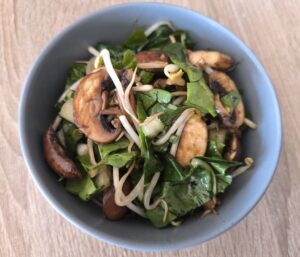
I also love foraging, finding new types of wild edibles to pick and eat. So when I heard that the fruit of the ice plant was edible, I knew I had to try it out.
Last year when I went to the seaside on vacation, I picked a fruit from an ice plant, took a bite, and promptly spit it out. It was disgusting. Slimy, salty, sweet, mushy, seedy. Uch.
I didn’t understand how people ate such things- they were quite revolting, and as I said above, I’m not easily turned off by foods, no matter how strange.
But eat them they do.
Ice plants, carpobrotus edulis, it turns out, are a native of South Africa, but they’re cultivated in gardens around the world, from where they’ve spread as an invasive species, covering large areas. (My next door neighbors have ice plants growing in their garden.)The plants are made of lots of light or dark green finger like fleshy leaves on a greenish or reddish mat of stems, leaves that have 3 distinct sides and moist insides like aloe or other succulents. They have either yellow, white, or magenta, or purple flowers that remind me a bit of sea anemones. South Africans call the fruit of this plant sour figs, sea figs, or hottentot figs, and commonly use them in jams.
Recently, when I went back to the coast, I again saw ice plants, and as I was on a quest to see what I could forage on vacation, I decided to give hottentot figs another chance, so that maybe this time I could finally see the appeal that these strange little fruit had for South Africans. Fortunately, I got it right, and now know how to make these fruit actually taste edible.
Here’s a mat of ice plants growing.
Here’s one ice plant flower in the sea of ice plant leaves.
When the flowers mature, the petals fall off while the ovaries of the plant swell up, leaving the ice plant with a bunch of greenish purplish orange fruit that kind of look like ping pong balls with horns.
Now here’s the important part, the part I only learned now.
Do not take a bite of the fruit as is, unless you want to be grossed out as I was the first time I tried them.
The outside of the fruit is an icky, slimy, salty layer. Inside it is a little fruit that is seedy and sweet.
To eat it, first peel off the outside, as I show step by step in the pic below, and then eat the inside.
As far as I know, there are no poisonous look a likes.
I wasn’t able to find nutritional information for the plant.
Medicinal benefits of ice plants:
The leaf juice is antiseptic, and is gargled to treat throat and mouth infections. It is taken orally for dysentery, digestive troubles, tuberculosis and as a diuretic. It is applied externally to treat eczema, wounds and burns. It is said to be effective against toothache, earache and oral and vaginal thrush. Mothers used to wipe the baby’s mouth after lactation, with a cloth soaked with the juice of the sour fig.
(From here)
I haven’t tried cooking with these, but after I finally figured out the trick in how to eat them, I was just eating one after the other after the other, all I could get my hands on. They taste good. They’re still slimy, but at least once you peel them they’re not sweet, salty, and slimy!
Have you ever seen ice plants growing? Ever seen the fruit? Ever eaten the fruit? Did you know the fruit was edible?
Have there been any foods that the first few times you ate them, you thought they were so gross, only to find out afterward that you were eating them incorrectly, and that’s why they tasted so bad? What food was it?
Linking up to Simple Lives Thursday










0 Responses
I understand that this Sour Fig flower is packed with Rutin an anti-fatigue agent and an amazing bioflavanoid.
I got my fix last week while visiting Antibes on the French Reviera. Beautifully dried figs, growing horizontally on their vines. With permission to pick some, I soaked, peeled and cooked. What a treat. Managed to bring a small jar back to Canada. Declared at Customs as "fig confiture"!!
I got my fix last week while visiting Antibes on the French Reviera. Beautifully dried figs, growing horizontally on their vines. With permission to pick some, I soaked, peeled and cooked. What a treat. Managed to bring a small jar back to Canada. Declared at Customs as "fig confiture"!!
A Turksvy is a Prickly Pear
A Turksvy is a Prickly Pear
I just LOVE sour figs and I can eat them by the pound….
Hi Im in South Africa, do you have them? Ineed them for nutritional analysis testing for my MSc degree
Ice plants are invasive at the coast here, I'll have to make it a habit to harvest the fruits! But I'd REALLY love to find out how best to prepare the leaves to eat as I hear they are edible too, but I'm not fond of slimy-ness!
Im originally from Cape Town and have eaten these as a kid, right through to adulthood. I'm residing in the Philippines now and wanted to know 2 things:
1) Does anyone know if these are available in the Philippines?
2) Will they grow in a full tropical climate?
Thanks in advance to anyone who can help.
Im originally from Cape Town and have eaten these as a kid, right through to adulthood. I'm residing in the Philippines now and wanted to know 2 things:
1) Does anyone know if these are available in the Philippines?
2) Will they grow in a full tropical climate?
Thanks in advance to anyone who can help.
i have if you still need
i have if you still need
do you still need? im in Durban Hillcrest, i have tons….0829413501
do you still need? im in Durban Hillcrest, i have tons….0829413501
Can you please place the receipt of pickled sour fig leaves..much appreciated.
Can you please place the receipt of pickled sour fig leaves..much appreciated.
Can I eat the leaves of plant? I chew them and swallow the juice..I was diagnosed with H-pylori virus…and must say it ease the pain in my stumic. Please let me know if I can eat the juicy leaves..I'm still living lol
Can I eat the leaves of plant? I chew them and swallow the juice..I was diagnosed with H-pylori virus…and must say it ease the pain in my stumic. Please let me know if I can eat the juicy leaves..I'm still living lol